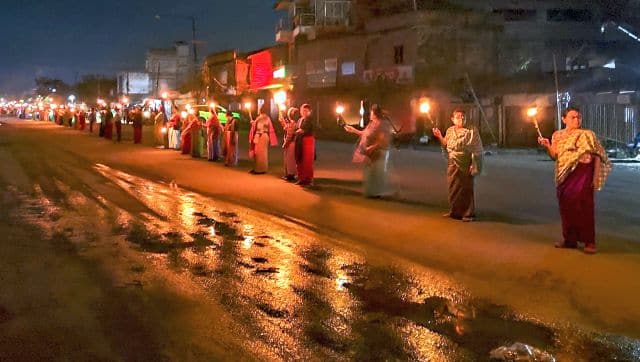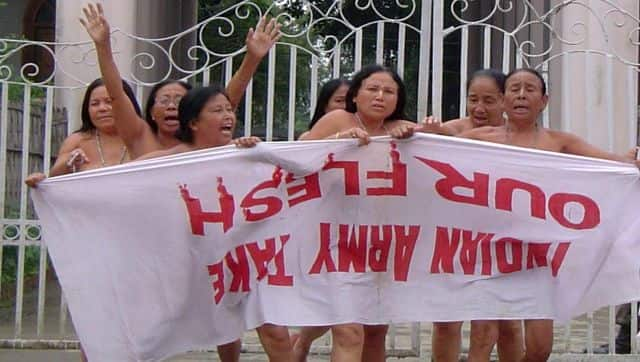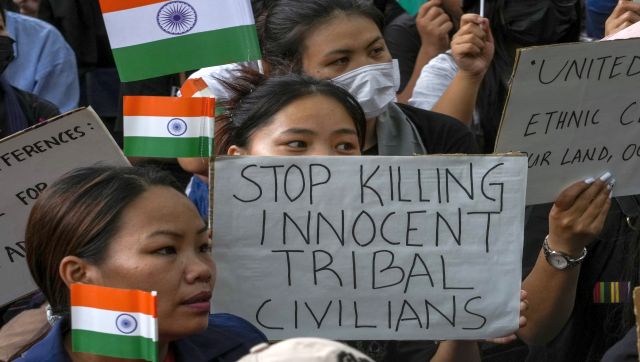Peace continues to elude Manipur. The northeastern state has been seeing large-scale violence and incidents of vandalism, looting and arson since early May. The government records show that 115 people have died and nearly 40,000 have been displaced due to ethnic clashes. Home Minister Amit Shah also reached the state to try and calm the air, but success has yet to be achieved. Amid all of this, the Indian Army on Monday said that women protesters in Manipur have been accompanying and abetting “armed rioters” and interfering in the operations of security forces in the state. Additionally, the Army stated that it was not only “unlawful but also detrimental to their efforts towards restoring law and order”. “The Indian Army appeals to all section of society to cooperate with Security Forces working day and night to bring peace and stability in Manipur,” it added. As protests and tensions continue in Manipur owing to the Kuki-Meitei clashes, we take a closer look at how women have become a crucial part of the movement as well as past instances when they occupied centre stage during stirs in the state. Women-led protests On Monday, the Indian Army released a video showing women surrounding personnel in Itham on Saturday. It said this incident was an instance of women “helping rioters flee”. The video showed visuals of heavy machinery digging a part of a road with a large number of women around it and stated that this was the entry and exit to an Assam Rifles base being dug up to cause delay.
Women activists in #Manipur are deliberately blocking routes and interfering in Operations of Security Forces. Such unwarranted interference is detrimental to the timely response by Security Forces during critical situations to save lives and property.
— SpearCorps.IndianArmy (@Spearcorps) June 26, 2023
🔴 Indian Army appeals to… pic.twitter.com/Md9nw6h7Fx
Prior to this, on Saturday, the Indian Army was forced to “hand over” 12 cadres of Kanglei Yawol Kanna Lup (KYKL), a banned insurgent group in Manipur, after a mob of 1,200 to 1,500 people led by women surrounded and stopped them from going ahead with an operation in Imphal East district. The Indian Army later confirmed that 12 insurgents, including self-styled Lt Col Moirangthem Tamba alias Uttam, who had been the mastermind behind the ambush on the 6 Dogra regiment in 2015, had been given up owing to the mob of women.
**Also read: Little has changed in Manipur over 25 years: A heady cocktail of ethnic and tribal strife** The statement by the forces read: “A mob of 1,200 to 1,500 people led by women and the local leaders immediately surrounded the area and prevented the security forces from going ahead with the operation. Repeated appeals to the aggressive mob to let the security forces carry on with operation as per law did not yield any positive result.” These are not the only instances when women have been at the forefront of protests. On 23 June, according to the India Indian Army, a large group of women stopped the movement of additional security personnel in an area bordering Kangpokpi and Imphal East district, where “armed miscreants” opened fire in two villages. [caption id=“attachment_12793752” align=“alignnone” width=“640”] Women from Manipur stage a protest over the ongoing violence in the state, at Jantar Mantar in New Delhi. PTI[/caption] And not just Delhi. Women from Manipur have also led protests against the violence by Meitei and Kuki groups at Jantar Mantar and outside Union home minister Amit Shah’s residence. Women have been seen across the state on several occasions since May, forming human chains to condemn the violence in the state. On 17 June, women from the Meitei community held torches and formed a human chain on the streets of Imphal East, Imphal West, Thoubal and Kakching districts. [caption id=“attachment_12793762” align=“alignnone” width=“640”]
 Women form a human chain to protest against the ethnic violence between Meitei and Kuki community people in Manipur, in Imphal on 17 June. PTI[/caption] Woman power in Manipur It comes as no surprise that women have been at the forefront of the protests in Manipur and also blocking the Army from conducting operations in the state. There’s a long history of women standing up to the powers in the state and this is just a continuation of that trend. In 1904, it was the women of Manipur that led a revolt against the tyrannical practices of the British. Lt Col Henry St Patrick Maxwell, the British agent of Manipur, in July 1904, had passed a rule that required men to perform 10 days of free labour after every 30 days. Protesting against this, thousands of women marched to Maxwell’s official residence, demanding that the orders to reintroduce the so called Lallup system be taken down and this came to be known as the First Nupi Lan (Women’s War). The second Nupi Lan took place in 1939. In July and August of that year, excessive rains had damaged the paddy production and the farmers had appealed to the durbar to ban rice exports in order to meet local demand. However, facing pressure from exporters, the durbar overturned its decision which led to women coming out on to the streets, demanding a ban. The situation led to a major clash, forcing the maharaja to stop the rice exports. [caption id=“attachment_12793962” align=“alignnone” width=“640”]
Women form a human chain to protest against the ethnic violence between Meitei and Kuki community people in Manipur, in Imphal on 17 June. PTI[/caption] Woman power in Manipur It comes as no surprise that women have been at the forefront of the protests in Manipur and also blocking the Army from conducting operations in the state. There’s a long history of women standing up to the powers in the state and this is just a continuation of that trend. In 1904, it was the women of Manipur that led a revolt against the tyrannical practices of the British. Lt Col Henry St Patrick Maxwell, the British agent of Manipur, in July 1904, had passed a rule that required men to perform 10 days of free labour after every 30 days. Protesting against this, thousands of women marched to Maxwell’s official residence, demanding that the orders to reintroduce the so called Lallup system be taken down and this came to be known as the First Nupi Lan (Women’s War). The second Nupi Lan took place in 1939. In July and August of that year, excessive rains had damaged the paddy production and the farmers had appealed to the durbar to ban rice exports in order to meet local demand. However, facing pressure from exporters, the durbar overturned its decision which led to women coming out on to the streets, demanding a ban. The situation led to a major clash, forcing the maharaja to stop the rice exports. [caption id=“attachment_12793962” align=“alignnone” width=“640”] A group of naked Manipur women hold a banner as they protest outside the Indian Army Assam Rifles anti-terrorism unit barracks in Imphal on 16 July 2004. File image/Reuters[/caption] In the 1970s, it was the women (Meira Paibis – Women with Torches) again who carried out non-violent protests for action against illicit liquor, use of drugs and more specifically the imposition of the
Armed Forces (Special Powers) Act (AFSPA). Perhaps, one of the most important and significant women protests in the country and in the state came on 15 July 2004. Twelve Manipuri women stripped naked in front of the Kangla fort in Imphal and held a banner that said ‘Indian Army Rape Us’. The nude protest came as a reaction to the brutal rape and murder of 32-year-old Thangjam Manorama by the 17th Assam Rifles. Manorama was picked up from her home on the pretext of interrogation by the Assam Rifles under AFSPA over being suspected of being a militant. Her body was found the next day with 16 bullets, her genitals destroyed and several marks in her thigh. [caption id=“attachment_12793992” align=“alignnone” width=“640”]
A group of naked Manipur women hold a banner as they protest outside the Indian Army Assam Rifles anti-terrorism unit barracks in Imphal on 16 July 2004. File image/Reuters[/caption] In the 1970s, it was the women (Meira Paibis – Women with Torches) again who carried out non-violent protests for action against illicit liquor, use of drugs and more specifically the imposition of the
Armed Forces (Special Powers) Act (AFSPA). Perhaps, one of the most important and significant women protests in the country and in the state came on 15 July 2004. Twelve Manipuri women stripped naked in front of the Kangla fort in Imphal and held a banner that said ‘Indian Army Rape Us’. The nude protest came as a reaction to the brutal rape and murder of 32-year-old Thangjam Manorama by the 17th Assam Rifles. Manorama was picked up from her home on the pretext of interrogation by the Assam Rifles under AFSPA over being suspected of being a militant. Her body was found the next day with 16 bullets, her genitals destroyed and several marks in her thigh. [caption id=“attachment_12793992” align=“alignnone” width=“640”] Irom Sharmila Chanu undertook a hunger strike for 16 years, starting in November 2000. File image/Reuters[/caption] The action by the women, later came to be called as the
Mothers of Manipur , led to the ouster of the Assam Rifles from Kangla Fort, and the removal of AFSPA from seven Assembly segments in Imphal. Who can also forget Manipur’s Iron Lady
Irom Sharmila ? She undertook a 16-year hunger strike, demanding the removal of AFSPA from the state. During her strike, which began on 5 November 2000, she was arrested by the police and charged with an “attempt to commit suicide”. Additionally, she was also force-fed on many occasions to keep her alive. It was only in August 2016 that the activist ended her strike, in order to compete in local elections. While she didn’t get the results, she was hoping – she only received 90 votes during the 2017 Assembly elections – Sharmila is probably the most famous protester in India. With inputs from agencies Read all the Latest News , Trending News , Cricket News , Bollywood News , India News and Entertainment News here. Follow us on
Facebook,
Twitter and
Instagram.


)

)
)
)
)
)
)
)
)



